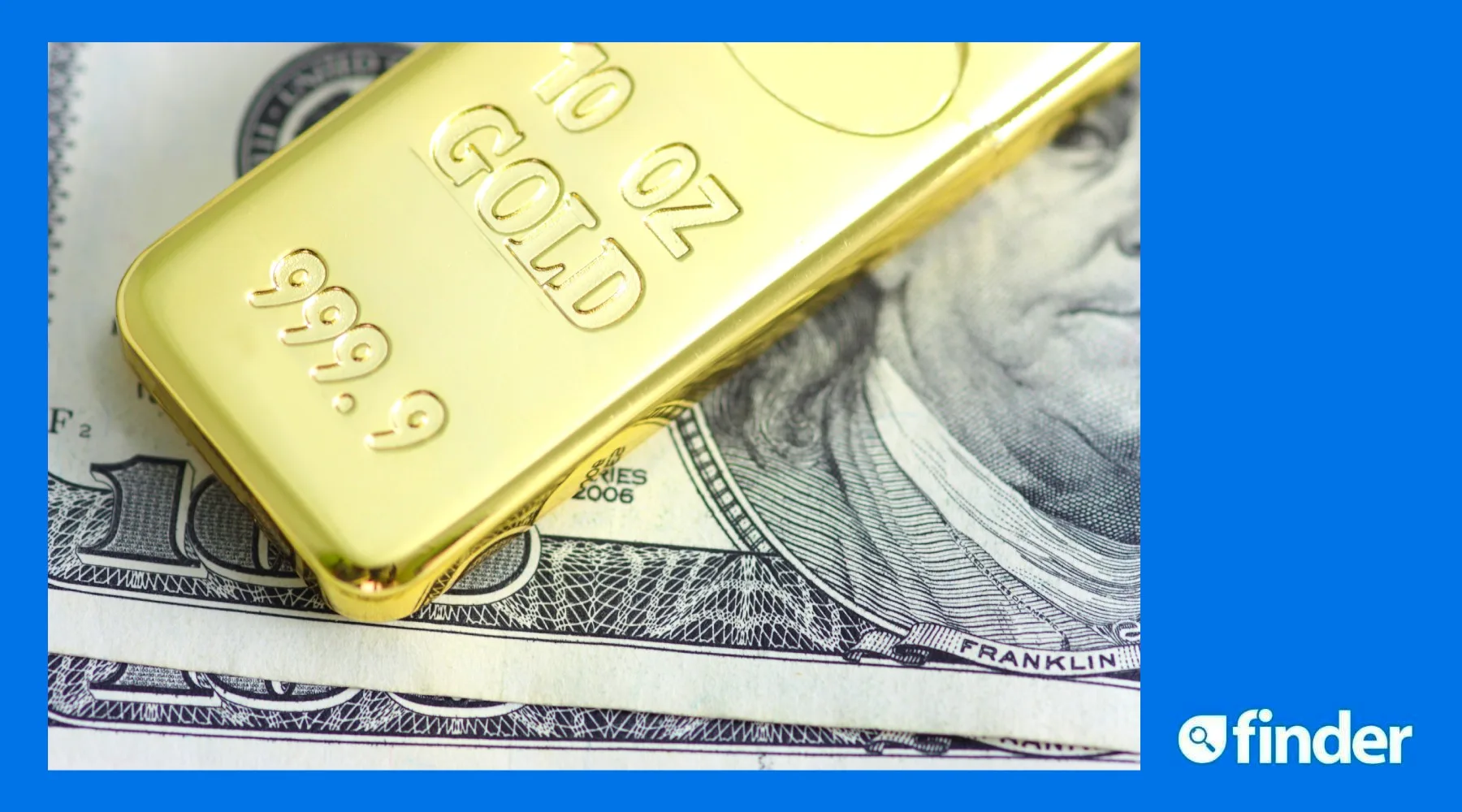Bullion, gold stocks or gold futures – which performs best?

For many, gold is an important part of a diversified portfolio. Here are several ways to invest in it.
 Sponsored by ACY Securities (AFSL 403863) – the Australian broker with a wide range of global CFDs across stocks, forex, indices, commodities, ETFs, crypto and low spreads via easy to use trading platforms. Trade precious metal CFDs such as gold, silver and platinum and speculate your view – whether that's long or short.
Sponsored by ACY Securities (AFSL 403863) – the Australian broker with a wide range of global CFDs across stocks, forex, indices, commodities, ETFs, crypto and low spreads via easy to use trading platforms. Trade precious metal CFDs such as gold, silver and platinum and speculate your view – whether that's long or short.
Sponsored by ACY Securities (AFSL 403863) - the Australian broker with a wide range of global CFDs across stocks, forex, indices, commodities, ETFs, crypto and low spreads via easy to use trading platforms. Trade precious metal CFDs such as gold, silver and platinum and speculate your view – whether that's long or short.
Gold has been considered a store of value for thousands of years, but in the last few decades it has also gained importance as a financial asset.
This is because investing in gold is considered a valuable hedge against inflation and a safe way to diversify a portfolio, given its stability during periods of market volatility.
With market turmoil spiking over the last few months, this investment avenue is again in the spotlight.
"Although its price has dropped, gold is more resistant to a bear market," ACY Securities markets analyst, Peter Pan, says, pointing to a 15% decline from peak for gold, compared to a 33% decline from peak for the Nasdaq 100.
"As a component of the portfolio, it could reduce total market risk exposure. Gold is still an essential choice for diversification."
Here are a few different ways to start investing in/trading gold. Let's take a look at how each option has been performing (note: our list is only indicative and does not cover the entire market).
Physical gold
Investment in physical gold can be done in the form of either gold bullion or by way of jewellery or those commemorative gold coins your neighbour has.
Bullion refers to gold that is at least 99.5% pure and has been transformed into bars or ingots or minted into coins. It is the form in which gold is traded on commodities markets around the world.
On the other hand, gold jewellery accounts for the largest use of physical gold although it can be of varying purity.
Performance
Gold prices jumped during the coronavirus pandemic, hitting a record US$2,074.88 an ounce in August 2020. The price again spiked to US$2,052.60 an ounce in March 2022. It is trading at US$1,712.76, down 2.1% from a year ago.
Pros
- Tangible asset, easy to buy.
- Hedge against inflation as its value goes up.
- Diversifies portfolio.
Cons
- Safety and physical storage is required.
- Not very liquid and may involve additional costs.
- Unlike property or shares, doesn't provide any ongoing income.
Gold stocks
These are stocks from companies involved in the mining and production of gold. The category is typically dominated by miners, but also provides access to gold streaming and royalty companies, which fund mining efforts in exchange for the opportunity to buy gold at a set price in the future.
Investing in gold companies' shares can be an effective way to profit from gold and also carries carries a potentially lower risk profile than other investment methods.
Some of the top gold stocks on the ASX include Newcrest Mining (ASX: NCM), Northern Star Resources (ASX: NST), Evolution Mining and (ASX: EVN).
Performance
Gold stocks can see wild variations depending on the nature of the company as well as market factors. Typically, stocks of smaller exploratory gold companies show a bigger outperformance but can often be much riskier. On the other hand, larger gold corporations manage to generate heavy profits even when gold prices are declining, but their shares are steady.
For instance, the top-performing gold stock on the ASX is Santana Minerals (ASX: SMI) with a 230% increase in value year on year to 66 cents, following a recent gold find in New Zealand.
By comparison, Australia's biggest gold producer Newcrest Mining posted a full-year profit of $872 million, but its share price is down 22.5% over the last 12 months.
Pros
- Effective way to profit from gold.
- Relative safety of investment in listed companies.
- Offers portfolio diversification.
Cons
- Stock performance can vary widely.
- Riskier option compared to some other investments.
- Additional costs such as broker fees.
Gold futures
Given gold's intrinsic quality as a natural hedge against inflation as well as its popularity as a portfolio diversification tool, many investors try to profit from gold price movements by trading in the futures market, where they don't own the asset itself, but instead own contracts based on the price changes.
"For long-term investors, ETFs may be suitable; but for short-term hedging or speculation, futures are preferred," Pan says.
In Australia, investors typically trade contracts for difference (CFDs) in the futures market using a specialised trading platform, for example ACY Securities.
Contract for difference (CFD) traders seek to make a profit from gold price movements – whether up or down. That means even if the price of a gold currency pair (or gold-related Share CFD) fall, then CFD owner can still make a profit, as well as a loss. Given their risky and complex nature, these instruments are better suited to advanced traders.
[Sponsored] Precious metals are one of the most volatile trading products in the international markets. To grow your experience prior to trading live, ACY Securities offers a free demo account with $100k virtual funds.
Performance
"The most popular gold CFDs across the world, including Australia, is the XAU/USD (gold price in USD) because of its trading volumes and better liquidity," Pan says. The XAU/AUD (gold price in AUD) is also widely used by Australian traders.
The XAU/USD is down 2.6% over a 1-year period. By comparison, the XAU/AUD pair has delivered 11.2% return over the same period.
Pros
- No need to worry about storage costs of physical gold.
- Can go long and short using CFDs.
- Leverage can be used to take advantage of price volatility.
Cons
- Involves a higher degree of risk and experience.
- CFD holding fees, forex risks.
- Exposure to market volatility.

Gold ETFs
Gold-based exchange-traded funds (ETFs) are a good alternative to investing in physical gold for small investors, because while they allow you to profit from the gold price, they are more cost-effective as the minimum investment is only the price of a single share of the ETF.
Most gold ETFs track the price movements of the commodity itself, an index tracking multiple companies with gold exposure or in stocks of gold mining and exploration companies.
Top gold-themed ETFs available in Australia include:
- VanEck Vectors Gold Miners ETF (GDX)
- BetaShares Global Gold Miners ETF (MNRS)
- BetaShares Gold Bullion ETF (QAU)
- ETFS Physical Gold (GOLD)
- Perth Mint Gold (PMGOLD)
Performance
As with stocks, the performance of gold ETFs can vary widely depending on the composition of their portfolio, performance of individual company shares as well as market factors.
The best performers in this category have been the bullion-focused Perth Mint Gold and the ETFS Physical Gold funds, which delivered 1-year returns of 8.5% and 8.4%, respectively. By comparison, the BetaShares Global Gold Miners ETF saw a (7.7%) return over the same period.
Pros
- Cost-effective way to profit from gold.
- Relative safety of listed security.
- No individual company research needed.
Cons
- Performance can vary widely.
- Riskier option compared to physical gold.
- Exposure to market volatility.
Trade Gold with ACY Securities
Compare other CFD trading platforms here


